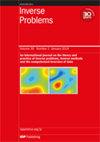在度量空间中实现逆问题的最佳传感器布局
IF 2
2区 数学
Q1 MATHEMATICS, APPLIED
引用次数: 0
摘要
这项工作的目的是量化具有度量和随机噪声的稀疏反问题中的重建误差,其动机是优化传感器布置。要在这种情况下发挥作用,误差量必须在传感器配置中显式存在,并且对信号源具有鲁棒性,同时与通过大量样本直接评估误差相比,在实践中相对容易计算。具体而言,我们考虑从受到高斯噪声污染的有限数量的测量结果中识别由未知点源线性组合组成的测量结果。恢复的统计框架依赖于两个主要因素:第一,Radon 测量空间上的凸但非平滑的变分 Tikhonov 点估计器;第二,基于其与地面实况的海灵格-康托洛维奇距离的适当均方误差。为了量化误差,我们采用了非退化源条件以及细致的线性化论证,得出了一个可计算的上界。这就得出了渐近尖锐的期望误差估计值,这些误差估计值在传感器配置中是明确的。因此,它们可用于估计给定传感器配置的预期重建误差,并指导稀疏逆问题中传感器的布置。本文章由计算机程序翻译,如有差异,请以英文原文为准。
Towards optimal sensor placement for inverse problems in spaces of measures
The objective of this work is to quantify the reconstruction error in sparse inverse problems with measures and stochastic noise, motivated by optimal sensor placement. To be useful in this context, the error quantities must be explicit in the sensor configuration and robust with respect to the source, yet relatively easy to compute in practice, compared to a direct evaluation of the error by a large number of samples. In particular, we consider the identification of a measure consisting of an unknown linear combination of point sources from a finite number of measurements contaminated by Gaussian noise. The statistical framework for recovery relies on two main ingredients: first, a convex but non-smooth variational Tikhonov point estimator over the space of Radon measures and, second, a suitable mean-squared error based on its Hellinger–Kantorovich distance to the ground truth. To quantify the error, we employ a non-degenerate source condition as well as careful linearization arguments to derive a computable upper bound. This leads to asymptotically sharp error estimates in expectation that are explicit in the sensor configuration. Thus they can be used to estimate the expected reconstruction error for a given sensor configuration and guide the placement of sensors in sparse inverse problems.
求助全文
通过发布文献求助,成功后即可免费获取论文全文。
去求助
来源期刊

Inverse Problems
数学-物理:数学物理
CiteScore
4.40
自引率
14.30%
发文量
115
审稿时长
2.3 months
期刊介绍:
An interdisciplinary journal combining mathematical and experimental papers on inverse problems with theoretical, numerical and practical approaches to their solution.
As well as applied mathematicians, physical scientists and engineers, the readership includes those working in geophysics, radar, optics, biology, acoustics, communication theory, signal processing and imaging, among others.
The emphasis is on publishing original contributions to methods of solving mathematical, physical and applied problems. To be publishable in this journal, papers must meet the highest standards of scientific quality, contain significant and original new science and should present substantial advancement in the field. Due to the broad scope of the journal, we require that authors provide sufficient introductory material to appeal to the wide readership and that articles which are not explicitly applied include a discussion of possible applications.
 求助内容:
求助内容: 应助结果提醒方式:
应助结果提醒方式:


